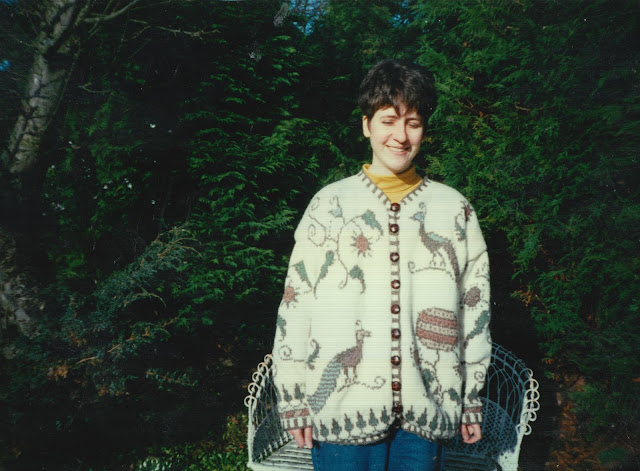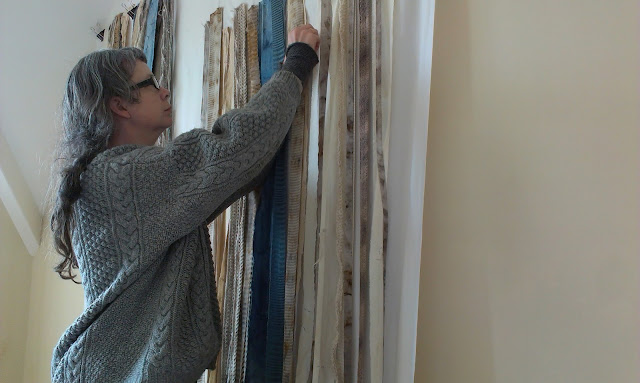peacock cardigan / jack's back cardigan
One can argue that objects, and specifically, knitted objects, contain coded archives and histories that compel the wearer to keep a garment for longer lengths of time than a garment that was mass manufactured. The only time a garment may move on is if it is shared, and normally that is within a wearer’s own family or a close friend.
I have received two pieces of knitwear from family members, and over ten knitted jumpers (mass manufactured) have been passed on to me by my best friend. The following object history details the story behind the peacock cardigan passed down to me by my mother.
Mother to daughter
The above images show scanned 35mm photographs of my mother, Rosemary, wearing a cream cardigan with a striped button placket, emblazoned with various imagery - including various peacocks and swirls. On the back of the first picture is a date - the 24th February 1991. The cardigan was knitted by her that year, and was worn on and off for many years after that. It was knitted and worn primarily due to the need for warmth and comfort, the relaxed fit (known in knitwear as a positive ease) allows for movement and the wool chosen reflected the need for softness.
The following image shows a photograph (selfie) taken of myself by myself, wearing the same cardigan, which was shared on Instagram. The cardigan was passed on to me a few days before the image below was shared online, and since then has been worn for the same reasons as it was created. It is a huge, chunky cardigan that, due to its quilted lining, offers a huge amount of warmth. When she gave me the cardigan she noted that the lining meant it was super warm, and it would help when the flat I was staying in at the time, in Aberdeen, had no central heating (and slugs, but we won't discuss that here). There were many evenings that having this cardigan on, even to bed, meant I was much more comfortable and able to wake up at normal times. Beforehand I was more prone to waking up in the middle of the night shaking from the cold. This cardigan meant I was kept warm and much healthier over that winter.
Grandmother to granddaughter
The below images show photographs taken in 2014 and 2015, respectively, showing myself wearing a colour work cardigan knitted by my grandmother, Valerie. The pattern is by Kaffe Fassett, a well known and revered knitwear designer who uses Fairisle and colour. My grandmother knitted this in the 1980s, and it was for my late grandfather. It was a perfect size and used very often by him. My grandmother then, upon learning of my fondness for knitting, decided to pass it on to me as it was not being used by him now. The size of the cardigan in comparison to my own is huge, but that adds to its comfiness. The cardigan was my grandmother’s first attempt at colour work and looking at it closely you can tell from the yarn slightly unravelling. I take great care when wearing it so that it does not snag on anything, but even then it is hard to stop it unravelling when it starts. Eventually I will decide to not wear it so as to keep it intact, but for now it not only offers comfort and warmth, particularly in winter, but lets me think back to when my grandfather was still alive, and reminds me to phone my grandmother.
This particular Kaffe Fassett jumper is called jack's back and came in a lovely large box, according to Valerie, that held the pattern and all the yarn needed for the project. It is strikingly different to mass-manufactured knitwear in that it is knitted horizontally (sleeve to sleeve) instead of vertically (top to bottom and vice versa). It is very easy to snag on things, and considering I use knitting machines quite often I am surprised it has not unravelled a lot more. As it is so large I have not been able to move it around with me as I have moved around the country, which is a shame as I love to wear it.
A fond memory of wearing it was helping at an After Hours event in the Aberdeen Art Gallery in 2014, before it was closed for refurbishment. The gallery was holding an exhibition on Kaffe Fassett and his use of colour, and I was helping to teach people to knit in a workshop while wearing this cardigan. I got many compliments that night, from lovely older ladies who are big fans of Kaffe Fassett, and I was able to proudly say my granny had knitted it.
This particular Kaffe Fassett jumper is called jack's back and came in a lovely large box, according to Valerie, that held the pattern and all the yarn needed for the project. It is strikingly different to mass-manufactured knitwear in that it is knitted horizontally (sleeve to sleeve) instead of vertically (top to bottom and vice versa). It is very easy to snag on things, and considering I use knitting machines quite often I am surprised it has not unravelled a lot more. As it is so large I have not been able to move it around with me as I have moved around the country, which is a shame as I love to wear it.
A fond memory of wearing it was helping at an After Hours event in the Aberdeen Art Gallery in 2014, before it was closed for refurbishment. The gallery was holding an exhibition on Kaffe Fassett and his use of colour, and I was helping to teach people to knit in a workshop while wearing this cardigan. I got many compliments that night, from lovely older ladies who are big fans of Kaffe Fassett, and I was able to proudly say my granny had knitted it.
These two garments attest to the power of a garment, and a knitted object, to provoke strong feelings of memory. The nostalgia that is created by wearing these garments is one that is definitively positive. A knitted object given with love will offer comfort and nostalgia in its purest form, and in the instance of washing it evokes a great sense of loss for a garment that is irreplaceable. Nostalgia has its benefits, and implementing it in this way is arguably a positive thing. Dawson (1) states that “even if you work from an existing pattern, where every detail has been worked out for you and is given in row-by-row instructions, the resulting garment will still be stamped with your individual mark.” The garments passed to me hold a great significance because of the mistakes created by the hands of my family members, and show a sense of individuality despite having been created through the use of patterns.
The above writing is extracted and expanded on from my BA Dissertation "Nostalgia and the knit stitch: looking at the past in contemporary culture in the context of knitting" (2017).
1. DAWSON, P., 1976. Knitting fashion: a step by step guide to knitting and crochet. London: British Broadcasting Corporation. p. 9.







Comments
Post a Comment